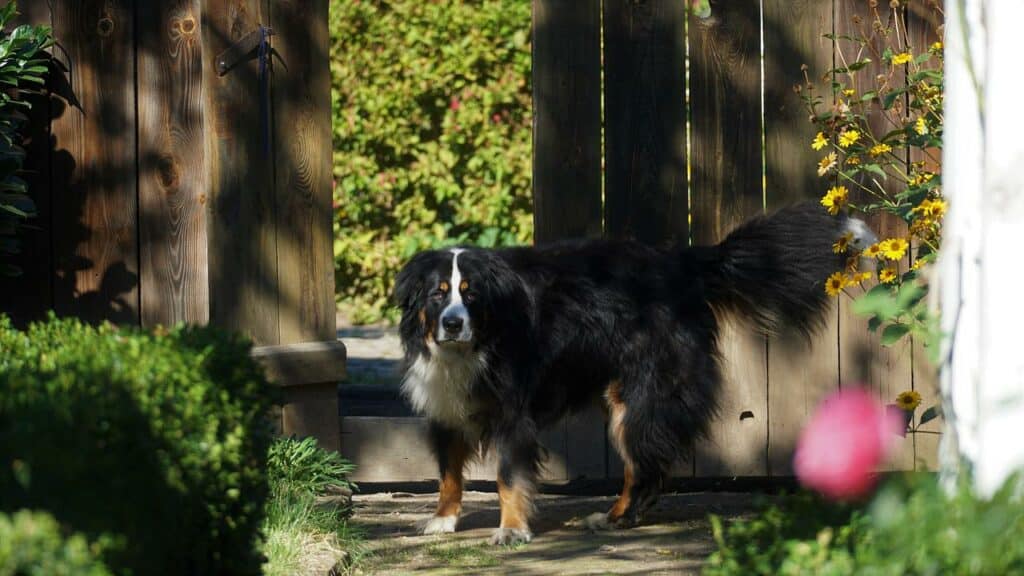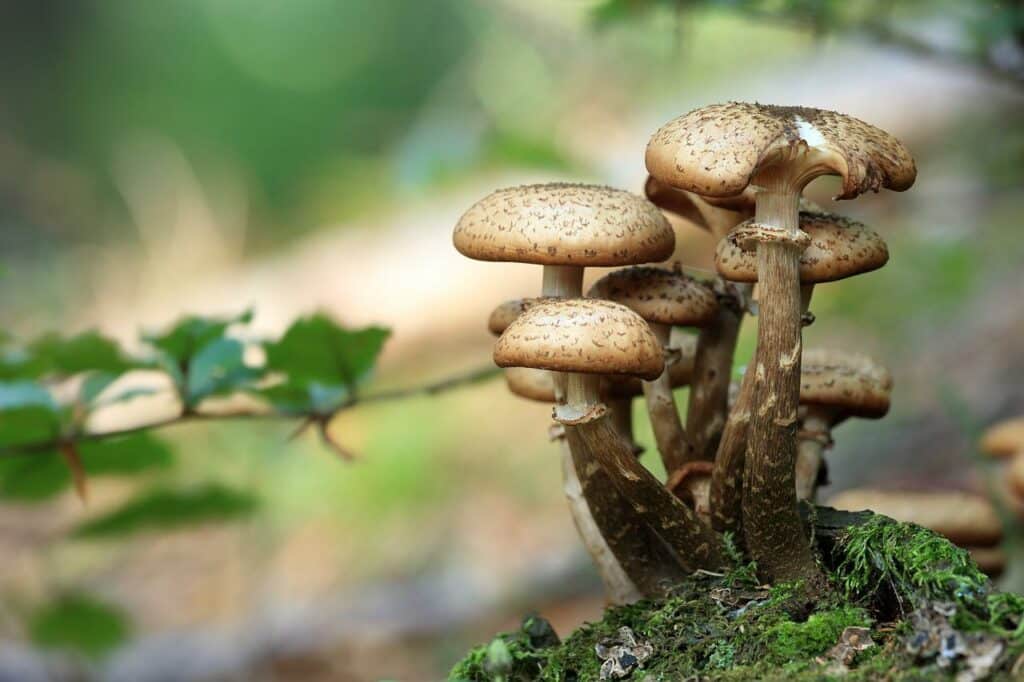After it has stopped raining, you take a stroll around the yard as the sight appeals to the eye.
You contemplate tagging the canine buddy along but decide against it.
Midway, you spot some mushrooms that have cropped up, and it makes you thrilled that the dog remained behind, given the scary stories you’ve heard about dogs and mushrooms.
Holding one in your hand, you wonder, are mushrooms that toxic?
Can dogs eat mushrooms in the yard?
No, dogs shouldn’t eat mushrooms in the yard because although some types are edible and wouldn’t harm the dog in any way, others would.
The problem lies in identifying whether the mushrooms in your yard are toxic for your dog or not. It’s not a worthy risk.
Mushrooms are a complex group of food.
It’s a fungus that mostly erupts naturally in the yard.
While a big percentage are edible and harmless to your dog, others can land your pet in the ER.
This article explores the dangers of letting your dog eat the mushrooms in your yard and how to prevent and handle the situation.

Can Dogs Eat Mushrooms?
Dogs can eat mushrooms but not from the yard.
The problem with mushrooms from the yard is that you wouldn’t know whether the species will be toxic to the dog or not.
There are close to 14,000 species of mushrooms, most of which are edible and not poisonous to dogs.
Learning the non-toxic ones, unfortunately, remains the elephant in the room.
Dogs are naturally curious creatures and, when walking around the yard, will sniff and taste anything that spikes their interest.
Unfortunately, mushroom foraging has landed many dogs on the ER table.
If you want your dog to benefit from mushroom nutrients, you are better off buying them from the store.

Types of Wild Mushrooms That Are Toxic to Dogs
Wild mushrooms can easily sprout in the yard; if your dog has easy access to the space, it will help to know which types are harmful.
The best way to tell whether the species sprouting in your backyard is toxic or not would be to have it examined by experts.
Familiarizing yourself with the toxic types will be a step in the right direction as it will guide you on when to be cautious.
Some of the mushroom types toxic to dogs include:
- Gyromitra
- Clitocybe dealbata
- Amanita phalloides (Death cap)
- Deadly Gallerina
- Amanita Muscaria
- Gemmata
Unless you are well versed with the types, it would be hard to identify them by name.
If you spot the mushrooms sprouting, it would be best to deny the dog access until proven the species is safe for consumption.
The Amanita Phalloides, for instance, is a common one in most yards and quite toxic.
Since dogs love to explore and are triggered by scent, taste and texture, they would easily try this type.
It’s soft and has a fishy smell. Dog owners will tell you most dogs have a thing for anything with a fish-like smell.
Symptoms of Wild Mushroom Toxicity in Dogs
Dogs will react differently to mushroom toxicity.
The level of impact will be determined by the time that has elapsed since consumption, type of mushroom and amount ingested.
Your dog’s prevailing health conditions, age and size will also affect how fast the wild mushroom affects the dog.
For instance, an elderly weak dog will suffer the consequences faster than an agile adult.
Symptoms of the wild mushroom toxicity include:
- Imbalance
- White projected eyes
- Diarrhea
- Throwing up
- Restlessness
- Seizures
- Twitching and convulsions
- Dehydration
- Frailness
If your dog has been out in the yard and you spot a combination of these factors, you need to act fast and contact a vet for further guidance.
Delayed response can lead to acute organ damage and eventual loss of your dog.
How to Prevent the Dog From Eating Mushrooms in the Yard
Mushrooms come in so many species, and it would be hard to tell the toxic ones at a glance.
This makes it imperative that you are proactive anytime your dog has access to the yard.
To prevent the dog from feeding on the mushrooms, you can implement several measures:
- Lawn Care and Maintenance
One sure measure to prevent mushroom toxicity on your dog is to clear and properly maintain the lawn.
Unfortunately, preventing the dog from accessing the yard can be hard, especially the active breeds.
Since mushroom is a type of fungi, you need to ensure that conditions that encourage fungi growth are eliminated.
Mainly, ensure you feed your lawn enough water as too much would mean sogginess, which is a recipe for fungal growth.
Keep the grass short and remove all unnecessary clippings.
Ensure that the soil you use is well aerated so that air can move freely.
Mushrooms will grow on soil that doesn’t allow enough air through.
- Pruning
If you are keen, you’ll notice mushroom mostly grows under the trees where the soil is moisturized and light is limited.
Pruning will allow the sun to penetrate, keeping the soil less moisturized and limiting mushroom growth.
- Spray Mushroom Killer
You need to be proactive in protecting your dog from mushroom poisoning, and the one sure way is to get rid of them completely.
Make a concoction of vinegar, water, or even baking soda and water and spray it on the mushroom heads.
The spray will eliminate the mushrooms, though slowly.
- Tie the Dog
Ensure you have the dog tied on a leash as you walk around your yard.
Dogs are naturally curious, and the mushroom’s smell and texture will have the dog tempted to taste it.
It takes as little as a bite for some mushrooms to harm the dog; therefore, it’s noble to have the dog under control when on a walk.
What To Do When Your Dog Eats Mushroom In the Yard
Once you realize your dog has consumed mushrooms in the yard, contact the veterinarian immediately.
Don’t even try to treat the dog yourself, as there’s no sure home remedy for mushroom poisoning.
You should act fast because the toxicity may be gradual, and the effects could worsen with time.
How the dog reacts to the mushroom poisoning could be determined by its overall health, size and age.
Act fast to help save your pet.
If possible, carry some samples of the mushrooms with you so the vet can easily identify the type of toxic content the dog ingested.
Conclusion
The good mushrooms contain high nutritional value, making them a staple in most of our meals.
Toxic ones, however, have devastating effects on a dog’s health.
If you want the dog to benefit from the nutrients mushrooms, have to offer, get them from the stores.
Your dog is safer that way.
It’s a tough task to know all the mushroom species and distinguishing the toxic ones is even harder.
Those stocked in stores have been vetted and approved as harmless.
- What Dog Breeds Have Pink Skin? - March 24, 2023
- What Are the Most Inspiring Dog Breeding Quotes? - March 20, 2023
- Can Pheromone Spray Help Improve Dog Breeding Results? - March 19, 2023








